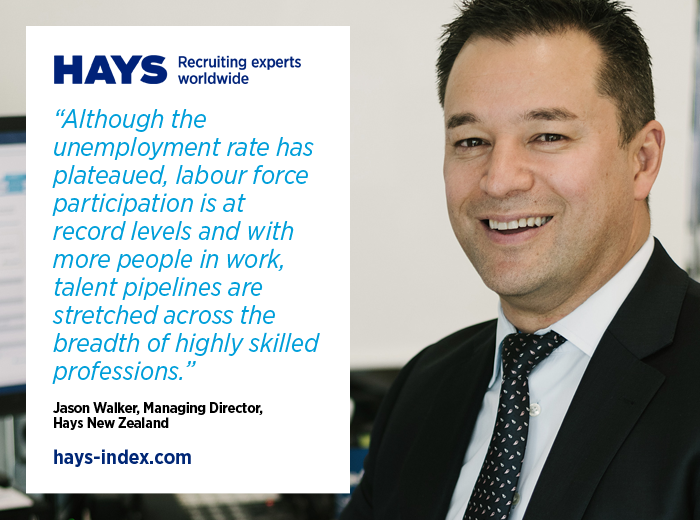
New Zealand has been given the highest score possible – 10.0 – for wage pressure in our high-skill industries in a global assessment of the efficiency of skilled labour markets in 31 countries.
The Hays Global Skills Index, produced in collaboration with Oxford Economics and released today, scores New Zealand’s labour market against seven indicators, or points of potential pressure. For each indicator New Zealand received a score out of 10. A score close to 0 indicates little to no pressure, while a score close to 10 shows severe pressure.
The Index shows that in New Zealand, pressure on our labour market comes from two of these indicators. The first is ‘wage pressure in high-skill industries’, which measures the rate at which wages in high-skill industries outpace those in low-skill industries. For the second consecutive year New Zealand received the highest possible score of 10.0, which shows that wages in high-skill industries are rising much quicker than those in low-skill industries relative to the past.
“This supports what we’re seeing on the ground, namely acute industry-specific skill shortages and employers in high-skill industries like engineering, construction and technology competing for talent,” says Jason Walker, Managing Director of Hays in New Zealand.
The second is ‘labour market participation’, for which New Zealand received a moderately high score of 6.7. This indicator measures the degree to which New Zealand’s talent pool is fully utilised.
“Bringing more people into the workforce is a powerful way to improve economic and labour market performance,” says Jason. “But pressure comes because most of our labour force is already utilised and therefore the available talent pool can’t be increased in great numbers – so we can’t relieve the skill shortage by raising the participation rate.
“The weakening of the NZ dollar has boosted the export sector, and with continued residential building activity, the next phase of the Christchurch rebuild, major government infrastructure investment and pending large scale commercial developments across the country, organisations are still experiencing skill shortages in many skilled industries.
“Although the unemployment rate has plateaued, labour force participation is at record levels and with more people in work, talent pipelines are stretched across the breadth of highly skilled professions.
“Therefore there is a talent shortage in high-skill industries and the candidate pool is unable to expand to ease demand. As a result employers need to find new ways to identify, attract and secure top talent,” he said.
For the remaining five indicators, the Hays Global Skills Index ranked New Zealand fairly positively. Our education system is well equipped to meet future talent needs (we received 4.7 for ‘education flexibility’), our labour market legislation is fairly flexible (4.3 for ‘labour market flexibility’), candidates usually possess the skills employers are looking for (4.7 for ‘talent mismatch’), and real wages are not rising quickly and are keeping pace with historic trends (2.8 for ‘overall wage pressure’). These are all positives for our labour market since they indicate low pressure points.
Interestingly, while New Zealand received the highest score possible for ‘wage pressure in high-skill industries’, it received a very low score of 2.5 for the last indicator of ‘wage pressure in high-skill occupations’. As Jason explains, “Some occupations require a higher than average amount of training and education. These are called high-skilled occupations. This indicator measures if there is a wage premium for such highly-skilled professionals. While we received a low score, the score has more than doubled year-on-year, from 1.2 in 2014 to 2.5 this year, which suggests that while there’s definitely no wage premium for high-skill occupations, people in high-skill jobs are starting to see some increases relative to low-skill occupations.”
About the Hays Global Skills Index
The Hays Global Skills Index assesses the efficiency of the skilled labour market in 31 countries, or its ability to supply skilled labour. The Hays Global Skills Index provides a score for each country of between 0 and 10 which measures the pressures present in its labour market. The score is calculated through an analysis of seven equally weighted indicators, each covering different dynamics of the labour market. Three indicators explore the supply of talent, namely education flexibility, labour market participation and labour market flexibility. One looks at talent mismatch. The final three are wage pressure indicators, looking at overall wage pressure, wage pressure in high-skill industries and wage pressure in high-skill occupations.
A score of 5.0 indicates a balanced picture for labour markets, a score close to 0 indicates less intense competition for vacancies, and a score close to 10 shows severe difficulty in finding skills.
The Hays Global Skills Index report, titled ‘Labour markets in a world of continuous change’, can be viewed at
www.hays-index.com.
Hays, the world’s leading recruiting experts in qualified, professional and skilled people